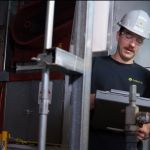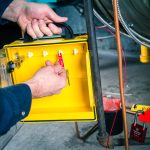

John is production director of a department in a manufacturing factory. When there is a padlock to be made on machinery, he notices that employees often look for equipment, padlocks and/or accessories they have to go to different places to find everything you need to padlock.
In addition, he notes that employees do not know what is picked out and how to apply the padlock. It is aware that this causes risk of accident in addition to loss of time, and therefore production.
John is concerned about witnessing several incidents in his sector and does not know where to start. He is continuously on the “Quiet”, namely when the next accident arrives and he knows very well as all of us :
A locking accident is always serious !
Such a context should never exist in any professional field. Unfortunately, it happens every day to more or less large degrees.
In order to avoid accidents in padlocking, it is important, to see essential to audit all of your system on a regular basis in order to have a clear action plan and ensure the maintenance of the achievements.
The main types of cadling audit
There are two listening audits that it is essential to set up, that of the system itself, that is to say the program and the policies which define “the rules of the game” and that which evaluates if the resources use it correctly.
The internal audit, which is done on a regular/monthly basis, lets you know where we are, if we have improved or if we regress. If you decide to invest in your padlock system, but you have nothing about what to base you, namely “where I am leaving?” “, How will you know if your” X “investment thousands of dollars for improving a system has given the anticipated results? The audit allows you to invest in the right place.
From the audit, you can define a plan with actions to be taken over a period of time that suits you. To maintain a padlock system, it is essential to invest each year. There is always room for continuous improvement in practices.
It is important to communicate the results of the audits in your organization, in order to maintain a high score for each assessment. You surely want to be the best at any time. The audits are elements that are continuously done. They must be done so as to have a sampling that represents your entire organization. If for example, by quarters of work, by sector, per period, etc., you must make audits in order to have the most precise image.
What is it for?
Auditing Your Lockout System Serves Several Purposes
Auditing the current lockout situation allows for the development of a detailed action plan—sometimes in multiple phases—and this plan demonstrates due diligence. It also enables the employer to prioritize actions in a project aimed at improving the lockout system.
First and foremost, auditing the lockout system provides a snapshot of the current situation—understanding “where we’re starting from.”
It helps identify improvement points. The audit also supports continuous improvement, as it’s recommended to be conducted monthly with random sampling during that period. Regular performance monitoring allows you to:
- Maintain the efficiency of the lockout system;
- Optimize the system’s operation;
- Track corrective actions;
- Ensure a return on investment over the years;
- Allocate budgets based on audit priorities.
Through regular follow-up, managers ensure they maintain a return on investment by evaluating financial benefits related to:
- Recruitment, onboarding, and training of new employees;
- Staff retention;
- Employee satisfaction and motivation;
- Preservation of expertise;
- Reduced risk of errors;
- Less time spent drafting lockout procedures;
- Less time applying lockout processes;
- Less time preparing for planned shutdowns;
- Decreased production losses.
What Elements Should Be Audited in a Lockout Program?
Audit elements include:
- The written lockout program itself;
- The lockout procedures;
- Implementation of those procedures;
- Identification of isolation devices;
- Lockout accessories;
- Placement of equipment in appropriate locations;
- Special situations (e.g., shift changes, lock removal, etc.);
- Training.
Who Should Conduct the Lockout Audit?
As mentioned earlier, the maintenance and continuous improvement audit should be performed monthly by a competent internal person. However, the more formal audit should be done annually by an external, independent, and impartial individual—someone who brings a different perspective from those within the organization. Related documentation should be kept for at least three years.
Why Should the Audit Be Conducted by an Experienced External Person?
Simply to bring a fresh perspective to your practices.
ABC Inc. Under Audit
ABC Inc. is auditing its various departments. Bill, a maintenance team employee, performs his lockout as usual. However, he locks a hot water valve in the open position—just as written on the procedure, and how he has always done it. Thanks to his impartiality and expertise, the auditor had him correct the situation. The deficiency in the lockout procedure was thus addressed.
During another audit, a non-lockable valve was placed in a safe position, but the padlock was simply hung on it because the worker couldn’t find the mechanism required to properly lock it. A 5S review and reorganization of the lockout materials were then carried out to prevent this kind of issue.
Where to Start?
In a large facility, the audit can be performed by department or sector. It’s logical to focus the approach on systems affecting 80% of situations.
For example, are there lockout procedures for all equipment? In a perfect world, yes. However, priority should be given to the most frequently locked-out equipment. A service unit that doesn’t significantly impact production may not need a lockout procedure immediately—it can be created later when needed.
Standards
Don’t forget that in Quebec, you must comply with the Occupational Health and Safety Act (LSST). You must also follow Canadian lockout standards.
A lockout system can become quite complex, and errors can quickly accumulate (machine identification tag falls off, mistakes on a procedure, insufficient materials, wrong mechanism, faulty padlock, etc.). This accumulation of errors can eventually lead to an accident.
Key Takeaway
Lockout is everyone’s responsibility—from management to employees.
Fabtech ID has over 35 years of expertise in controlling hazardous energy. Our experts are available to support your lockout activities. Contact us for guidance today.







